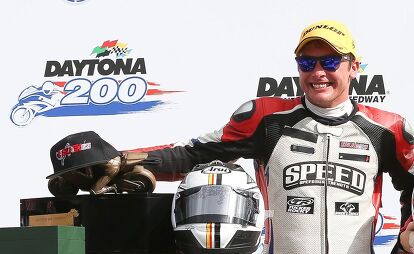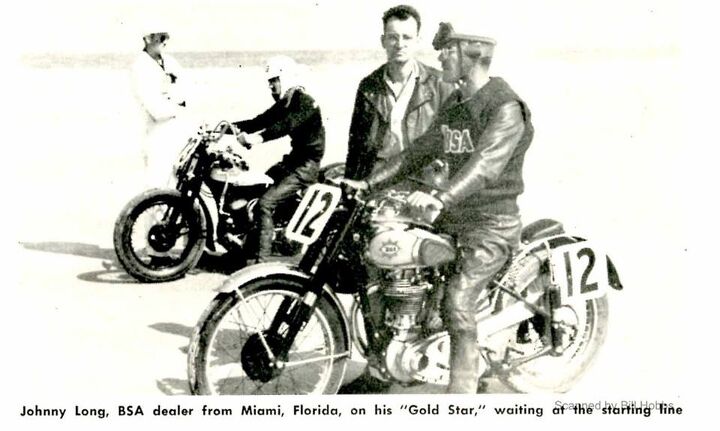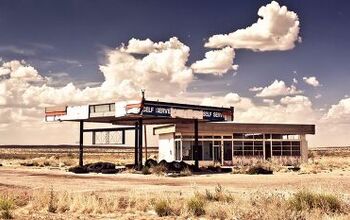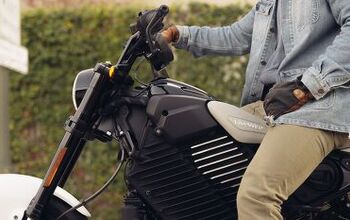The 2015 Daytona 200: Should You Care?
One of the world's greatest motorcycle races transforms again
Pulling into the camping area at Daytona for the 200 weekend is a reunion of sorts for me. I always meet a regular group of friends under NASCAR Turn 3, but this year seemed a bit different than the last few years.
There were at least twice the normal tents and campers in the area. Driving in three days early, the fences along the track’s infield were already lined up with RVs set to watch the race. And the conversations were different too: some speculated the race was going to just turn out to be a glorified club race, but others were more open minded – willing to see what it would be under the new promoter, not knowing exactly what to expect, but hoping for good racing. There was no doubting that more race fans were interested enough to come to the track and find out for themselves than had been showing up for the old show.
It’s become common for race promoters and publications to talk about “the Show” when describing plans for our sport. But when the placement of sponsor’s patches on a rider’s leathers becomes as important to the promoter as lap times are to the fan, something is wrong and everything/everyone suffers – both on and off track. And when a promoter has the ability to surreptitiously punish certain riders for speaking out publicly against policy or to bend rules for one manufacturer, then “the show” has gotten in the way of good racing – which is really all we come to the track for in the first place.
Throughout the past few years, attempts to add flash to the 200 have backfired – night races and the pace car easily come to mind. With the exception of the pre-race Fan Walk, which allows fans to get close to the bikes and riders, these gimmicks backfired. What works for NASCAR doesn’t seem to work for motorcycles, and both racers and fans were losing interest in America’s Greatest Race.
I already had more than a quarter century of motorcycling behind my taillight before attending my first Daytona 200 in year 2000. I’d been going to Bike Week for years and had gotten bored with the sameness and predictability of each visit, so I went to the speedway just to see something different. And I got hooked. Sitting in the first row of the grandstands near Turn 1, I watched Superbikes roar past, coming out of the tri-oval and leaning into the fast left-hander, then saw them come out of Turn 6 after running the infield and speed off onto the west banking. I wanted to follow them, and I did as best any new fan could.
I haven’t missed a 200 since. I learned the riders of the day – Mladin, Duhamel, Zemke, Hayden, Rapp – then began to study some of the history. I made friends with John Long who raced the 200 in the ’80s; his son Barrett is a current contender, and John’s father raced it back on the beach course in the ’40s.
I wasn’t just hooked on racing; I got sucked in. My friendship with John Long led to me getting a CCS license and I began racing myself. (My first race was in the Formula 40 class when I was on the downhill side of that age bracket.) I eventually did follow those factory riders onto the high banks, racing support classes during bike week on my Suzuki SV650. One of the greatest thrills of my life was sitting on the grid at Daytona and hearing Richard Chambers announce my name over the loudspeaker.
And I got involved in other ways also: I was just beginning a career as a motojournalist and covered the racing for a few publications, I worked the pits for friends who raced the 200 and other support races, and now, for the past half-dozen years, I’ve been part of a safety crew working corners during the races.
So with that history behind me, when rumors leaked out last fall that there may not be a 200 this year, I was understandably devastated. I didn’t believe the race would die, but there were many who felt it should – that it had outlived its relevance (whatever that means), that it didn’t have the draw it once did, that without the biggest baddest bikes with top-name riders and a prime-time TV package it doesn’t deserve to survive.
Bull!
The Daytona 200 has been through many transformations: Fans of the original 200 expressed the same sentiments about its death in 1961 when the race moved from the beach course to the track. Then in the ’70s and ’80s it grew into the biggest, most prestigious race in the world, drawing a huge international field and filling the grandstands with spectators. And it held that prestige until very recently.
When I first started going in 2000, the 200 was the headliner for almost two solid weeks of racing. It began with a trackday/racing school where newcomers could become comfortable with the track without the pressure of competition. That was followed with AHMRA – the American Historic Motorcycle Racing Association – which attracted vintage racers from all over the world. I remember a group of Australians who one year brought a dozen or so immaculately restored tank-shift Harleys to race Daytona. The sight and sound and smell of them all roaring through Turn 6 and working their way up the 31-degree bank was one of the most beautiful things I’ve ever seen or heard or smelled anywhere.
The old bikes were followed by a few days of club racing (where I was able to get my SV out on the track), then the AMA bikes – which incorporated the 200 as the headliner. And it all fit together under the umbrella of the Daytona 200.
Daytona is a unique track: tension between rider safety and speed is a big part of the Daytona 200 tradition. The first couple years after moving from the beach to the track, the bikes were not allowed to use the banking and were restricted to running the entire race on the infield course. Then, for the first decade or so after graduating to the high banks, no one changed rubber during the race and the entire 200 miles were run on a single set of tires before modern tire technology and fast tire changes caught up, briefly, with the needs of modern bikes at Daytona, which then allowed bikes to go faster and out-ride the tires again. So some compromise had to be made.
Do you race the ultimate bikes and place restrictions on them in the name of safety, or do you run lighter, less powerful bikes that don’t need artificial limitations and let them run to their maximum. Or do you throw the whole thing out because you can’t have it all? Those three options can be debated ad nauseum with no correct answer regarding the race itself.
The other gorilla in the paddock involves politics, personalities, egos and bank receipts – and I’m not qualified to address those issues other than to note that as of last October, when MotoAmerica entered the picture, the 200 was no longer an AMA-sanctioned race.
Personally, I think pulling the Daytona 200 from the calendar of a points-dependant championship and removing it from the faster-lighter-more powerful arms race of the big factories will give it the freedom to resume its place on the world’s stage.
With only a few months to get the race organized, ASRA/CCS chose to make it as inclusive as possible – allowing privateers a chance at the podium for the first time in decades. The rules allowed riders to choose their own tires and fuel rather than being restricted to a single spec brand. A substantial prize package of $175,000 paying back to 40th position (an increase from last year’s $105,000 paying back to 35th place), plus an additional $40,000 in contingency money gave more racers a chance to recoup a larger percentage of their expenses. It was a democratization of America’s premier race run on middleweight bikes that work well, both on the track and with racers’ wallets.
I’m sure no factory team would have been turned away, but the great thing was that no privateer felt out of place. The paddock had a few big transporters from well-funded riders, but it was also filled with bikes brought to the track on single-axle trailers and in pickups and vans.
Geoff May, who finished third, paid for his campaign through a crowd-funding program launched on Facebook and drove down from Georgia with his bike in the back of a van with the names of more than 80 contributors written on his bike.
Another rider, Jason Farrell from Wisconsin, ended up racing with an engine he found on eBay after both his primary and spare blew in practice. He drove across the state the night before the race to pick it up and got it installed in time to make the start. He could have been a top finisher but a crash and an ill-timed pit stop kept him mid-pack. There were five former 200 winners on the grid, which was the largest in many years.
The winner, Danny Eslick, rode for TOBC Racing, one of the better-funded teams, but was never a runaway leader and only passed second-place finisher Josh Herrin at the line on the final lap. This is a level of grass-roots racing closer to what the original Daytona 200 was about than anything most of us have seen. The racing was fantastic with more lead changes than I could count – sometime five or six changes in a single lap and many exciting mid-pack battles also. I couldn’t get exact attendance numbers from the track, but they did say they were extremely pleased with the turnout. It was also broadcast online on Fanschoice.tv.
Almost everyone I talked to after the race, in the paddock and in the stands, said it was one of the best they’ve seen. I’m excited by all this and hope it continues.
I couldn’t get any official comment from the track on what the future of the race will be other than “There will continue to be a Daytona 200.” My hope is that it will evolve into a world-class stand-alone race like the Isle of Man TT.
I’m excited with the direction MotoAmerica is taking with AMA racing and applaud their alignment with the Federation of International Motorcycling (FIM) and World Superbike (WSBK), even if that might keep them from returning to Daytona. It is an old track and might not meet FIM safety requirements (just as the Isle of Man doesn’t). No rider should feel obligated to race a track they are not comfortable on, but it would be a shame for racers who want to ride one of the world’s most historic races to be prevented from doing so.
I’ll be there next year for the 75th and hopefully for many years beyond to witness fantastic racing as the 200 transforms back into what it once was – not a show, but a headliner for great racing.
More by James Hesketh











































Comments
Join the conversation
The old man might not be around anymore, but his family and protege's are. All you have to do is look at how DMG tried to change the series, mold it into a clone-bike, nose-to-tail, going around in a circle BS. Noted by another poster, those ridiculous self-serving class names and rule-changes, plus running off the OEMs. All of "us" cried out "why don't you just align the names and rules with what just about every other national and world series does?" Oh, it's the economy. No one would speak out or speak up because it's the "great" nascar people. Yet every other national/regional series enjoys full stands, full grids, OEM support and participation, and sponsorship/TV deals. We can watch BSB on American TV, but not our own series? And if anyone does not think how motorcycle racing was marginalized and mismanaged by DMG, how about what DMG told Gill Campbell when Laguna was trying to get something going last year. They told her "we see no value in motorcycle racing." What? These are the people you really want running the series. Yet, in spite of that mentality, they were still resistant and reluctant to relinquish control to KRAVE and MotoAmerica. This is the ridiculousness that ran the series since 2008. Rainey, Askland and the team they put together are class acts. Who realize the value. Of course MotoAmerica wanted to distance themselves from DMG and Daytona. I've been watching the 200 since the first time it was on TV and every time since. Remember the old TNN network? It was on every year until Speedvision took over. Then even on Speed, nascar took priority and all the motorcycle support shows were pushed out. Even though Rick Miner said "don't worry, we won't become the nascar channel." Liar. I was done with Speed when I saw some nascar "person" going around, with his own show, cooking and doing BBQ. A COOKING SHOW with a nascar guy on Speed! The 200 is a great event, the race this year proved it. It deserves to be continued, but until the debacle that was DMG ownership loses the obvious black-eye, maybe MotoAmerica might consider adding it to the calender again. Rainey and co. know what they're doing.
Daytona was special for a lot of reasons not having anything to do with any the France family. To start with it was an escape from northern winters. Its date fit perfectly with spring sales campaigns Bringing the British and European Importers and eventually Japanese Factories. It became part of the F 750 championship this brought riders like Saarinen and Agostini to America. Now if you want to see the best riders in the world you need to go to Laguna Seca or Austin Tex. Being part of a world championship (World Endurance? WSBK ?) is the only way bring crowds of road race fans like me back to Daytona. I can see National Championship Superbike racing at better tracks and closer to home.